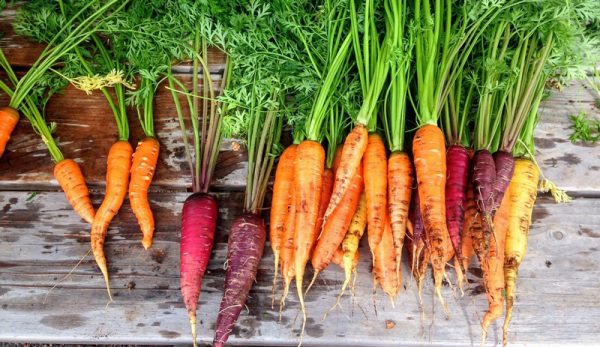
After spending an hour hand-weeding the tiniest grass and creeping Charlie seedlings from among my carrot seedlings, I want to tell you that growing carrots is a great idea for a small-scale farm.
Even though my pant-knees are caked with mud and I am recounting all that I could have done with that hour gone by, I’m really excited about the carrots I’ll harvest in two months.
When I worked on a small-scale diversified farm, we were just as likely to till in a crop that might not be worth “saving,” in favor of putting energy into the crops that would offer better return on time investment. But in this year’s 2,000-square-foot intensively cropped garden, the meals that will come from the past hour spent on hands and knees are my ROI.
How to Grow Carrots
Carrots germinate in a range of soil temps, making it possible to direct-seed them from early spring through mid-summer and again in the fall.
They need moisture to germinate, taking up to three weeks to sprout. Throw a row cover over them after direct-seeding to assist with this.
Leave on the row cover to help keep away flea beetles and carrot root maggot flies. (These things are also soil borne, as are carrot rust flies and wireworms, so you might also need beneficial nematodes or a serious crop rotation plan.)
Carrots are particular about their soil. As root crops, carrots are hungry for phosphorus. They also like deep soil to grow to their fullest potential. Rocks, poor soil and compacted clay can cause carrots to become misshapen and can stunt their growth.
That storybook stereotype of the naughty rabbit sneaking into the garden to eat the carrots: It’s real. Rabbits, groundhogs and deer love these sweet veggies as much as you do, so fencing them out is smart.
Get ahead of the weeds that I’m currently cursing with these great tips for weed-free carrot beds.
You can even grow carrots in containers.
Here are 6 tips for preparing your soil to grow better carrots.
How to Harvest Carrots
About two months after germination, you should have good-sized carrots for harvesting. You can also harvest sooner for baby carrots, if you just can’t keep your kids away from them.
Stick a digging fork into the soil about 6 inches away from your row of carrots, and rock the fork back to loosen the soil.
The carrots may pop right out of the ground, or you may need to give them a tug. Either way, it’s fun to see what comes up, as it’s hard to judge how large they’re getting under the soil.
Carrots as Storage Crops
Some carrot varieties store better than others. You’ll determine which work best for you.
Whatever variety you choose, remove the greens from the roots right after harvest to keep the roots fresh. Store the greens in the fridge in a plastic bag. Store the roots in the crisper drawer.
Carrots will keep for months in proper long-term storage, such as in a root cellar.
Types of Carrots
One tip for marketing carrots is to grow several varieties. There is no shortage of carrot varieties available to you, from your standard orange carrot-shaped carrots to a rainbow of colors and unusual shapes. (Today’s domesticated carrots’ ancestor was white: the wild carrot!)
Read about seven must-try carrot varieties in this article, and check out an impressive list of varieties from the World Carrot Museum.
Check out these 5 tips for marketing your carrots to customers!
How to Eat Carrots
Long under-respected for their culinary contribution, I feel like carrots are now getting some respect. They certainly get respect in my kitchen—otherwise I wouldn’t be spending an hour hand-weeding—and among farmers market shoppers.
Roasted carrots know no bounds. Glazed carrots are a famous side-dish to meat and potato meals. Roasted and puréed carrots add nutrition and flavor to hummus.
A few carrots in the bottom of the chicken-roasted pan add depth to the meal.
Personally, I love a puréed carrot-tomato soup recipe shared with me by a local chef. And don’t make me remind you of carrot cake.
On the raw carrot front, I couldn’t be happier with a raw salad of carrots grated with ginger and kohlrabi, tossed with lemon juice and salt.
And please use the whole vegetable! Save the carrot greens to make pesto, to use in place of parsley in a recipe or to add to your stock pot.
This multi-season root vegetable requires some patience and a certain tolerance for dealing with weeds but yields rewards in the kitchen, at harvest time and beyond.




